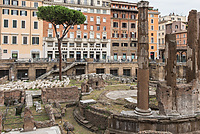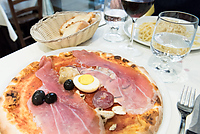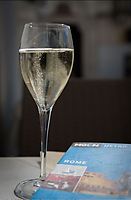Deaf Travel12th November 2015
When in Rome...
Natasha Hirst shares some more thoughts on her time in Italy - here, telling us all about wonders of Rome.
The phrase "Rome wasn't built in a day" is incredibly apt. A diverse city, steeped in history and culture, Rome is seriously visually astonishing. The larger architectural scale of Rome is breath-taking but so too is all the detail; in statues, exquisitely painted frescos, ornate hidden courtyards and beautiful carvings.
Our second day of sightseeing took us to the Roman Forum and the grand Colosseum, a must-see even if you aren't a fan of the film Gladiator. In the middle of the rush, traffic and buzz of the city is the Roman Forum, the ruins of Ancient Rome dating back to over 2800 years ago. It forms a striking but confusing mass of contradictions.

Top Tip: Have a good map with you here because it is easy to lose your bearings and the area is bigger than you might expect.
These ruins were once the social, political and commercial heart of the Roman Empire where important Government buildings, markets and temples stood. The influence that the Romans had and still have on our towns, architecture, transport infrastructure and culture is truly amazing when you stop to think about it. This influence spread outwards from Rome, until the fall of the Roman Empire in 476 AD. Following this time, the Forum fell into disrepair, as did many other urban areas developed by the Romans.
 How history has layered itself upon the ground is quite fascinating. Many excavations took place in the 18th and 19th Centuries, digging down to expose the ruins of these ancient structures. These explorations continue to reveal more detail, giving further glimpses into the lives of Ancient Romans. To be standing where it all began thousands of years ago was a profound experience. I tried to imagine what Rome would have looked like at the height of its glory. We can see from artwork how people dressed, we know from ancient texts and maps about key political figures, battles and wars and how the Roman Empire sought to conquer the world.
How history has layered itself upon the ground is quite fascinating. Many excavations took place in the 18th and 19th Centuries, digging down to expose the ruins of these ancient structures. These explorations continue to reveal more detail, giving further glimpses into the lives of Ancient Romans. To be standing where it all began thousands of years ago was a profound experience. I tried to imagine what Rome would have looked like at the height of its glory. We can see from artwork how people dressed, we know from ancient texts and maps about key political figures, battles and wars and how the Roman Empire sought to conquer the world.
 There are unexpected sights across Rome where modern is fused with ancient, and where the preservation of heritage goes hand in hand with a more modern day concern; for example, rehoming abandoned cats in the Torre Argentina cat sanctuary, based in the ruins of one of the oldest temples in Rome.
There are unexpected sights across Rome where modern is fused with ancient, and where the preservation of heritage goes hand in hand with a more modern day concern; for example, rehoming abandoned cats in the Torre Argentina cat sanctuary, based in the ruins of one of the oldest temples in Rome.
A short walk to the East of the Forum is the Colosseum, globally recognised as a symbol of the Roman Empire. It is the largest amphitheatre ever built and one of the greatest achievements of architecture and engineering. It has to be seen to be believed.
Top Tip: You can save queuing and book tickets online for the Colosseum and Forum. Check whether you have to collect the tickets outside the entrance to the Forum or at the Colosseum entrance. When you collect the tickets you'll be allocated a time slot to enter the Colosseum so the earlier you get there, the better. The tickets give access to the Forum (at any time that day or the next) but you do not have to go through the Forum to reach the Colosseum, they are separate sites. This was the biggest confusion for me!
The initial construction of the Colosseum took just 8 years, beginning in 72 AD. In its earliest days the amphitheatre would sometimes be flooded with water to hold naval battles, until further structures were added to the arena. At its height it would hold crowds of over 50,000 people who came to watch cruel and bloodthirsty events such as Gladiatorial contests, animal hunts and executions. Today, two thirds of the amphitheatre remains, due to damage from an earthquake, fires and the plundering of the stone for use in the construction of later palaces and churches. There has been a long running battle to preserve the remains from the creep of vegetation but recent conservation work has attracted criticism for being sponsored by private companies in exchange for advertising rights.

The dimensions of the Colosseum manage to dwarf the thousands of visitors it holds at any given moment. The precision and beauty in the arrangement of the many bricks, stones and arches is jaw dropping. It's impossible to do it justice with photographs.
Top Tip: If you are a keen photographer, you'll need a wide angle lens here. Beware tourists with selfie sticks, they are everywhere!


It is a surreal juxtaposition to see these iconic ruins, fallen pillars, broken statues and remains of temples now set against modern buildings, traffic and thousands of tourists with their smart phones and gadgets waving around in the air. What would ancient Romans think if they could ever have glimpsed their future to look at us as we looked back through history to see them?
Top Tip: Wear a solid pair of shoes. I wore mine through with three days of walking the uneven cobbled streets. Rome is not easy on the feet and I personally would find it hard to navigate it with very young children or if I had poor mobility.
Invest in a good guide book to really get the most out of Rome. There are many iconic sites spread around the city which you can walk between. Metros and trams also serve the city, although I didn't attempt to use them. A number of tourist attractions are being restored at this point in time and are obscured by scaffolding, such as the Spanish Steps and Trevi Fountain. Check online if there are any places you are really keen to see just in case they are closed.

Other must see sights (too many to list):
- The Pantheon was originally constructed in 27BC and rebuilt in 128AD. This magnificent structure consists of the widest masonry dome ever constructed, and contains an oculus (circular opening) at the top which is the only source of light into the building.
 Close to the Pantheon you can find second hand shops and interesting boutiques. Nearby, the area surrounding Piazza di Spagna is renowned for high fashion shopping, or window shopping depending on your budget! We settled for a fabulous pizza and watched the tourists wander by.
Close to the Pantheon you can find second hand shops and interesting boutiques. Nearby, the area surrounding Piazza di Spagna is renowned for high fashion shopping, or window shopping depending on your budget! We settled for a fabulous pizza and watched the tourists wander by.- Campo de' Fiori is well known for the daily morning market, and has a wide range of cafes, bars and restaurants around it. Just off the piazza is the unusual Ristorante Da Pancrazio which lays claim to being built over the remains of the Theatre of Pompey, where Julius Caesar was murdered. The food is great and the vault below the restaurant is eerily fascinating.
- From a cafe in the quaint Trastevere area, we watched a wedding take place in the Church of Santa Maria. Famous for its stunning mosaics by Cavallini, the church is thought to date back to 221AD, although having been restructured twice. The surrounding area has pretty side streets and many corks wedged between the cobbles, alluding to its reputation for lively night life.
- With a commanding view of the Vatican City, there is the Castel Sant'Angelo, originally built as a mausoleum of the Emperor Hadrian, also doubling as a fortress to defend the Vatican in the Middle Ages.
All of the key tourist attractions and monuments have signage in English and Italian with plenty of information on them. I didn't feel that I missed out by not using audio guides or guided tours. I much prefer to wander at my own pace which makes it easier to take photos too.
Top Tip: Public toilets are almost non-existent (there are some inside the Colosseum). Take a breather for an espresso, snack or a glass of wine at a cafe and there will usually be toilets available for customers.
 Along the wide tree-lined river especially, Rome often reminds me of Paris and it also has a very different feel to it from other regions of Italy. Rome is a wonderful city to wander through with quaint alleyways which frequently surprise you by opening onto any number of large piazzas. Lined with cafes and restaurants and more often than not, beautifully decorated churches, it is easy to find a comfortable spot for lunch, coffee or a sophisticated glass of wine.
Along the wide tree-lined river especially, Rome often reminds me of Paris and it also has a very different feel to it from other regions of Italy. Rome is a wonderful city to wander through with quaint alleyways which frequently surprise you by opening onto any number of large piazzas. Lined with cafes and restaurants and more often than not, beautifully decorated churches, it is easy to find a comfortable spot for lunch, coffee or a sophisticated glass of wine.
Article by Natasha Hirst, Deaf Writer
posted in Deaf Lifestyle / Deaf Travel
12th November 2015





